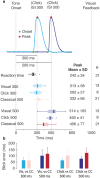Learning and Timing of Voluntary Blink Responses Match Eyeblink Conditioning
- PMID: 28611360
- PMCID: PMC5469802
- DOI: 10.1038/s41598-017-03343-2
Learning and Timing of Voluntary Blink Responses Match Eyeblink Conditioning
Abstract
Can humans produce well-timed blink responses to a neutral stimulus voluntarily, without receiving any blink-eliciting, unconditional, stimulus? And if they can, to what degree does classical eyeblink conditioning depend on volition? Here we show that voluntary blink responses learned in two paradigms that did not involve any unconditional blink-eliciting stimuli, display timing that is as good, or better than, the timing of blink responses learned in a standard eyeblink conditioning paradigm. The exceptional timing accuracy likely stems from the fact that, in contrast to previous studies, we challenged our participants to blink in a timed manner, and not merely to blink so as to avoid the corneal air puff. These results reveal a remarkable level of voluntary control over a simple movement, and they challenge the view that learning during eyeblink conditioning is necessarily automatic and involuntary.
Conflict of interest statement
The authors declare that they have no competing interests.
Figures




Similar articles
-
Classical Short-Delay Eyeblink Conditioning in One-Year-Old Children.J Vis Exp. 2018 Sep 1;(139):58037. doi: 10.3791/58037. J Vis Exp. 2018. PMID: 30222167 Free PMC article.
-
Children with autism spectrum disorders show abnormal conditioned response timing on delay, but not trace, eyeblink conditioning.Neuroscience. 2013 Sep 17;248:708-18. doi: 10.1016/j.neuroscience.2013.06.007. Epub 2013 Jun 14. Neuroscience. 2013. PMID: 23769889 Free PMC article.
-
Acquisition of conditioned eyeblink responses is modulated by cerebellar tDCS.Brain Stimul. 2014 Jul-Aug;7(4):525-31. doi: 10.1016/j.brs.2014.03.010. Epub 2014 Apr 3. Brain Stimul. 2014. PMID: 24776785 Clinical Trial.
-
Are Purkinje Cell Pauses Drivers of Classically Conditioned Blink Responses?Cerebellum. 2016 Aug;15(4):526-34. doi: 10.1007/s12311-015-0722-4. Cerebellum. 2016. PMID: 26400585 Free PMC article. Review.
-
Brain mechanisms of extinction of the classically conditioned eyeblink response.Learn Mem. 2004 Sep-Oct;11(5):517-24. doi: 10.1101/lm.80004. Learn Mem. 2004. PMID: 15466302 Review.
Cited by
-
The ability to maintain rhythm is predictive of ADHD diagnosis and profile.BMC Psychiatry. 2023 Dec 8;23(1):920. doi: 10.1186/s12888-023-05401-8. BMC Psychiatry. 2023. PMID: 38066477 Free PMC article.
-
A Longer Interstimulus Interval Yields Better Learning in Adults and Young Adolescents.Front Behav Neurosci. 2018 Dec 3;12:299. doi: 10.3389/fnbeh.2018.00299. eCollection 2018. Front Behav Neurosci. 2018. PMID: 30559655 Free PMC article.
-
Weak correlations between cerebellar tests.Sci Rep. 2020 Jun 2;10(1):9003. doi: 10.1038/s41598-020-65886-1. Sci Rep. 2020. PMID: 32488084 Free PMC article.
-
Fast implicit and slow explicit learning of temporal context.Sci Rep. 2025 May 10;15(1):16343. doi: 10.1038/s41598-025-01664-1. Sci Rep. 2025. PMID: 40348889 Free PMC article.
-
Feedback from HTC Vive Sensors Results in Transient Performance Enhancements on a Juggling Task in Virtual Reality.Sensors (Basel). 2021 Apr 23;21(9):2966. doi: 10.3390/s21092966. Sensors (Basel). 2021. PMID: 33922711 Free PMC article.
References
-
- Petter, E. J., Lusk, N., Hull, C., Hesslow, G. & Meck, W. Interactive Roles of the Cerebellum and Striatum in Sub-Second and Supra-Second Timing: Support for an Initiation, Continuation, Adjustment, and Termination (ICAT) Model of Temporal Processing. Neuroscience & Biobehavioral Reviews, doi:10.1016/j.neubiorev.2016.10.015 (2016). - PubMed
-
- Kehoe, E. J. & Macrae, M. In A Neuroscientist’s Guide to Classical Conditioning (ed. J. W. Moore) 171–231 (Springer-Verlag, 2002).
-
- Clark, R. E. & Squire, L. R. in Eyeblink Classical Conditioning Vol. 1 (eds D. S. Woodruff-Pak & J. E. Steinmetz) 229–251 (Springer US, 2002).
Publication types
MeSH terms
LinkOut - more resources
Full Text Sources
Other Literature Sources

